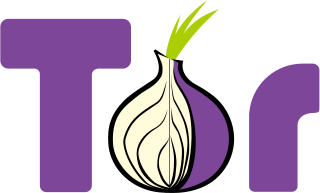Related Research Articles

Hyphanet is a peer-to-peer platform for censorship-resistant, anonymous communication. It uses a decentralized distributed data store to keep and deliver information, and has a suite of free software for publishing and communicating on the Web without fear of censorship. Both Freenet and some of its associated tools were originally designed by Ian Clarke, who defined Freenet's goal as providing freedom of speech on the Internet with strong anonymity protection.

Peer-to-peer (P2P) computing or networking is a distributed application architecture that partitions tasks or workloads between peers. Peers are equally privileged, equipotent participants in the network, forming a peer-to-peer network of nodes. In addition, a personal area network (PAN) is also in nature a type of decentralized peer-to-peer network typically between two devices.

GNUnet is a software framework for decentralized, peer-to-peer networking and an official GNU package. The framework offers link encryption, peer discovery, resource allocation, communication over many transports and various basic peer-to-peer algorithms for routing, multicast and network size estimation.

Onion routing is a technique for anonymous communication over a computer network. In an onion network, messages are encapsulated in layers of encryption, analogous to the layers of an onion. The encrypted data is transmitted through a series of network nodes called "onion routers," each of which "peels" away a single layer, revealing the data's next destination. When the final layer is decrypted, the message arrives at its destination. The sender remains anonymous because each intermediary knows only the location of the immediately preceding and following nodes. While onion routing provides a high level of security and anonymity, there are methods to break the anonymity of this technique, such as timing analysis.
An anonymous P2P communication system is a peer-to-peer distributed application in which the nodes, which are used to share resources, or participants are anonymous or pseudonymous. Anonymity of participants is usually achieved by special routing overlay networks that hide the physical location of each node from other participants.
A dark net or darknet is an overlay network within the Internet that can only be accessed with specific software, configurations, or authorization, and often uses a unique customized communication protocol. Two typical darknet types are social networks, and anonymity proxy networks such as Tor via an anonymized series of connections.

Mixminion is the standard implementation of the Type III anonymous remailer protocol. Mixminion can send and receive anonymous e-mail.

Tribler is an open source decentralized BitTorrent client which allows anonymous peer-to-peer by default. Tribler is based on the BitTorrent protocol and uses an overlay network for content searching. Due to this overlay network, Tribler does not require an external website or indexing service to discover content. The user interface of Tribler is very basic and focused on ease of use instead of diversity of features. Tribler is available for Linux, Windows, and OS X.
A Sybil attack is a type of attack on a computer network service in which an attacker subverts the service's reputation system by creating a large number of pseudonymous identities and uses them to gain a disproportionately large influence. It is named after the subject of the book Sybil, a case study of a woman diagnosed with dissociative identity disorder. The name was suggested in or before 2002 by Brian Zill at Microsoft Research. The term pseudospoofing had previously been coined by L. Detweiler on the Cypherpunks mailing list and used in the literature on peer-to-peer systems for the same class of attacks prior to 2002, but this term did not gain as much influence as "Sybil attack".
Garlic routing is a variant of onion routing that encrypts multiple messages together to make it more difficult for attackers to perform traffic analysis and to increase the speed of data transfer.
An anonymizer or an anonymous proxy is a tool that attempts to make activity on the Internet untraceable. It is a proxy server computer that acts as an intermediary and privacy shield between a client computer and the rest of the Internet. It accesses the Internet on the user's behalf, protecting personal information of the user by hiding the client computer's identifying information such as IP addresses. Anonymous proxy is the opposite of transparent proxy, which sends user information in the connection request header. Commercial anonymous proxies are usually sold as VPN services.
Privacy-enhancing technologies (PET) are technologies that embody fundamental data protection principles by minimizing personal data use, maximizing data security, and empowering individuals. PETs allow online users to protect the privacy of their personally identifiable information (PII), which is often provided to and handled by services or applications. PETs use techniques to minimize an information system's possession of personal data without losing functionality. Generally speaking, PETs can be categorized as either hard or soft privacy technologies.

Tor is a free overlay network for enabling anonymous communication. Built on free and open-source software and more than seven thousand volunteer-operated relays worldwide, users can have their Internet traffic routed via a random path through the network.
Tahoe-LAFS is a free and open, secure, decentralized, fault-tolerant, distributed data store and distributed file system. It can be used as an online backup system, or to serve as a file or Web host similar to Freenet, depending on the front-end used to insert and access files in the Tahoe system. Tahoe can also be used in a RAID-like fashion using multiple disks to make a single large Redundant Array of Inexpensive Nodes (RAIN) pool of reliable data storage.

Steven James Murdoch is Professor of Security Engineering in the Computer Science Department, University College London. His research covers privacy-enhancing technology, Internet censorship, and anonymous communication, in particular Tor. He is also known for discovering several vulnerabilities in the EMV bank chipcard payment system and for creating Tor Browser.
Internet censorship circumvention, also referred to as going over the wall or scientific browsing in China, is the use of various methods and tools to bypass internet censorship.
A distributed file system for cloud is a file system that allows many clients to have access to data and supports operations on that data. Each data file may be partitioned into several parts called chunks. Each chunk may be stored on different remote machines, facilitating the parallel execution of applications. Typically, data is stored in files in a hierarchical tree, where the nodes represent directories. There are several ways to share files in a distributed architecture: each solution must be suitable for a certain type of application, depending on how complex the application is. Meanwhile, the security of the system must be ensured. Confidentiality, availability and integrity are the main keys for a secure system.

Roger Dingledine is an American computer scientist known for having co-founded the Tor Project. A student of mathematics, computer science, and electrical engineering, Dingledine is also known by the pseudonym arma. As of December 2016, he continues in a leadership role with the Tor Project, as a project Leader, Director, and Research Director.
A wireless onion router is a router that uses Tor to connect securely to a network. The onion router allows the user to connect to the internet anonymously creating an anonymous connection. Tor works using an overlaid network which is free throughout the world, this overlay network is created by using numerous relay points created using volunteer which helps the user hide personal information behind layers of encrypted data like layers of an onion. Routers are being created using Raspberry Pi adding a wireless module or using its own inbuilt wireless module in the later versions.

George Danezis, FBCS is a computer scientist and Professor of Security and Privacy Engineering at the Department of Computer Science, University College London where he is part of the Information Security Research Group, and a fellow at the Alan Turing Institute. He co-founded Chainspace, a sharded smart contract platform, and was Head of Research before it was acquired by Facebook. After leaving Facebook he co-founded MystenLabs and is one of the designers of the Sui Blockchain. He currently works part-time as a Professor at University College London and as Chief Scientist at MystenLabs.
References
- ↑ "Free Haven". Freehaven.net. Free Haven Project. Archived from the original on 19 June 2014. Retrieved 4 June 2014.
- 1 2 3 4 Dingledine, R.; Mathewson, N.; Syverson, P. (2007). "Deploying Low-Latency Anonymity: Design Challenges and Social Factors" (PDF). IEEE Security & Privacy. 5 (5): 83–87. doi:10.1109/MSP.2007.108. S2CID 11387129. Archived (PDF) from the original on 2014-06-06. Retrieved 2022-01-04.
- ↑ Jordan, Tim (2008). "The Politics of Technology: Three Types of 'Hacktivism'". In Häyhtiö, Tapio; Rinne, Jarmo (eds.). Net Working/Networking: Citizen Initiated Internet Politics. University of Tampere. p. 267. ISBN 9789514474644. Archived from the original on 2015-03-19. Retrieved 2022-01-04.
- ↑ Hansen, J. A. (March 2010). "Adding privacy and currency to social networking". 2010 8th IEEE International Conference on Pervasive Computing and Communications Workshops (PERCOM Workshops). 2010 8th IEEE International Conference on Pervasive Computing and Communications Workshops (PERCOM Workshops). Mannheim. pp. 607–612. doi:10.1109/PERCOMW.2010.5470508.
- ↑ Hermoni, O.; Gilboa, N.; Felstaine, E.; Shitrit, S. (January 2008). "Deniability — an alibi for users in P2P networks" (PDF). 3rd International Conference on Communication Systems Software and Middleware and Workshops, 2008. COMSWARE 2008. Communication Systems Software and Middleware and Workshops. pp. 310–317. doi:10.1109/COMSWA.2008.4554432. Archived (PDF) from the original on 6 June 2014. Retrieved 3 June 2014.
- ↑ Dingledine, R.; Freedman, M. J. & Molnar, D. (2001). "The Free Haven Project: Distributed Anonymous Storage Service" (PDF). Lecture Notes in Computer Science 2009. Proc. Workshop on Design Issues in Anonymity and Unobservability. Springer-Verlag. Archived (PDF) from the original on 23 September 2015. Retrieved 2 June 2014.
- ↑ Mayeba, M.; Mirembe, D. P.; Otto, F. (2007). "Analysis of Free Haven anonymous storage and publication system" (PDF). Proceedings of SREC'07, Kampala, Uganda. SREC'07. Kampala, Uganda. pp. 380–389. Archived (PDF) from the original on 6 June 2014. Retrieved 3 June 2014.
- ↑ Chothia, T.; Chatzikokolakis, K. (2005). "A Survey of Anonymous Peer-to-Peer File-Sharing" (PDF). Lecture Notes in Computer Science. Embedded and Ubiquitous Computing – EUC 2005 Workshops. Springer Berlin Heidelberg. pp. 744–755. doi: 10.1007/11596042_77 . Archived (PDF) from the original on 13 August 2021. Retrieved 3 June 2014.
- ↑ Perng, G.; Reiter, M. K.; Wang, C. (June 2005). "Censorship Resistance Revisited" (PDF). Information Hiding. 7th International Workshop, IH 2005. Barcelona, Spain: Springer Berlin Heidelberg. pp. 62–76. doi:10.1007/11558859_6 . Retrieved 3 June 2014.[ permanent dead link ]
- ↑ Xiao, R. (July 2008). "Survey on Anonymity in Unstructured Peer-to-Peer Systems". Journal of Computer Science and Technology. 23 (4): 660–671. doi:10.1007/s11390-008-9162-7. S2CID 28191470. Archived from the original (PDF) on 2014-06-06.
- ↑ Oram, Andy (2001). Peer-to-Peer: Harnessing the Power of Disruptive Technologies . O'Reilly Media. ISBN 9780596001100.
- ↑ Yianilos, P. N.; Sobti, S. (September–October 2001). "The evolving field of distributed storage" (PDF). IEEE Internet Computing. 5 (5): 35–39. doi:10.1109/4236.957893. Archived from the original (PDF) on 2016-03-04.
- ↑ Sniffen, B. T. (22 May 2000). "Trust Economies in the Free Haven Project" (PDF). Thesis. Massachusetts Institute of Technology. Archived (PDF) from the original on 5 March 2016. Retrieved 3 June 2014.
- ↑ Viljanen, L. (August 2005). "Towards an Ontology of Trust" (PDF). Trust, Privacy, and Security in Digital Business. Second International Conference, TrustBus 2005. Copenhagen, Denmark: Springer Berlin Heidelberg. pp. 175–184. doi:10.1007/11537878_18. Archived (PDF) from the original on 7 June 2014. Retrieved 3 June 2014.
- ↑ Oppliger, R. (October 2005). "Privacy-enhancing technologies for the world wide web". Computer Communications. 28 (16): 1791–1797. doi:10.1016/j.comcom.2005.02.003.